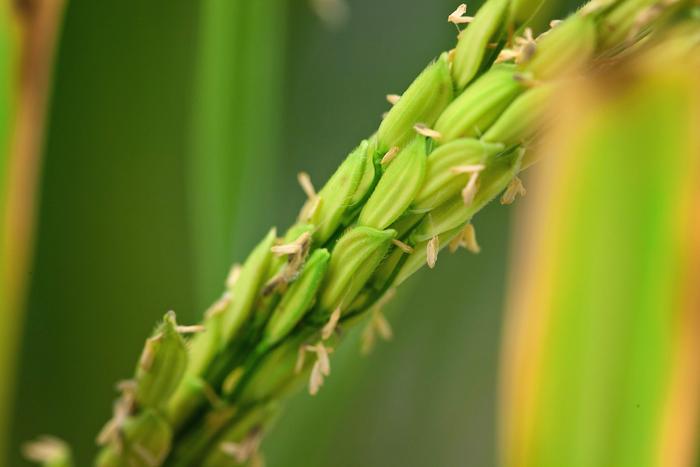A team from the Innovative Genomics Institute at the University of California, Berkeley (UCB) has produced an increase in gene expression in a food crop by changing its upstream regulatory DNA. While other studies have used CRISPR/Cas9 gene-editing to knock out or decrease the expression of genes, new research published in Science Advances is the first unbiased gene-editing approach to increase gene expression and downstream photosynthetic activity.

Credit: RIPE Project
A team from the Innovative Genomics Institute at the University of California, Berkeley (UCB) has produced an increase in gene expression in a food crop by changing its upstream regulatory DNA. While other studies have used CRISPR/Cas9 gene-editing to knock out or decrease the expression of genes, new research published in Science Advances is the first unbiased gene-editing approach to increase gene expression and downstream photosynthetic activity.
“Tools like CRISPR/Cas9 are accelerating our ability to fine-tune gene expression in crops, rather than just knocking out genes or turning them ‘off’. Past research has shown that this tool can be used to decrease expression of genes involved in important trade-offs, such as those between plant architecture and fruit size,” said Dhruv Patel-Tupper, lead author on the study and former postdoctoral researcher in the Niyogi Lab at UCB. “This is the first study, to our knowledge, where we asked if we can use the same approach to increase the expression of a gene and improve downstream activity in an unbiased way.”
Unlike synthetic biology strategies that use genes from other organisms to improve photosynthesis, the genes involved in the photoprotection process are naturally found in all plants. Inspired by a 2018 Nature Communications paper that improved the water-use efficiency of a model crop by overexpressing one of these genes, PsbS, in plants, the Niyogi lab, and its leader Kris Niyogi, wanted to figure out how to change the expression of a plants’ native genes without adding foreign DNA. According to the Food and Agriculture Organization, rice supplies at least 20% of the world’s calories, and because it has only one copy of each of the three key photoprotection genes in plants, it was an ideal model system for this gene editing study.
The Niyogi lab pursued this work as part of Realizing Increased Photosynthetic Efficiency (RIPE), an international research project led by the University of Illinois that aims to increase global food production by developing food crops that turn the sun’s energy into food more efficiently with support from the Bill & Melinda Gates Foundation, Foundation for Food & Agriculture Research, and U.K. Foreign, Commonwealth & Development Office.
The lab’s plan was to use CRISPR/Cas9 to change the DNA upstream of the target gene, which controls how much of the gene is expressed and when. They wondered if making those changes would have an impact on downstream activity and by how much. Even they were surprised at the results.
“The changes in the DNA that increased gene expression were much bigger than we expected and bigger than we’ve really seen reported in other similar stories,” said Patel-Tupper, now an AAAS Science and Technology Policy Fellow at the USDA. “We were a little bit surprised, but I think it goes to show how much plasticity plants and crops have. They’re used to these big changes in their DNA from millions of years of evolution and thousands of years of domestication. As plant biologists, we can leverage that ‘wiggle room’ to make large changes in just a handful of years to help plants grow more efficiently or adapt to climate change.”
In this study, RIPE researchers learned that inversions, or “flipping” of the regulatory DNA, resulted in increased gene expression of PsbS. Unique to this project, after the largest inversion was made to the DNA, the team members conducted an RNA sequencing experiment to compare how the activity of all genes in the rice genome changed with and without their modifications. What they found was a very small number of differentially expressed genes, much smaller than similar transcriptome studies, suggesting their approach did not compromise the activity of other essential processes.
Patel-Tupper added that while the team showed that this method is possible, it’s still relatively rare. Around 1% of the plants they generated had the desired phenotype.
“We showed a proof-of-concept here, that we can use CRISPR/Cas9 to generate variants in key crop genes and get the same leaps as we would in traditional plant breeding approaches, but on a very focused trait that we want to engineer and at a much faster timescale,” said Patel-Tupper. “It’s definitely more difficult than using a transgenic plant approach, but by changing something that is already there, we may be able to preempt regulatory issues that can slow how quickly we get tools like this into the hands of farmers.”
Journal
Science Advances
Method of Research
Experimental study
Subject of Research
Not applicable
Article Title
Multiplexed CRISPR/Cas9 mutagenesis of rice PSBS1 non-coding sequences for transgene-free overexpression
Article Publication Date
7-Jun-2024
COI Statement
The researchers do not report any conflicting interests.



